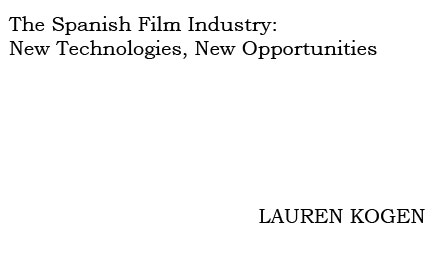

Going global
Over and above the potential to increase revenues in the domestic sector, revitalizing the Spanish film industry could allow it to better exploit the international markets. Spain is in a unique position with regard to the world film circuit, since it has two enormous markets beyond its borders. The EU-15 and the Spanish-speaking countries of Latin America total close to 730 million potential ticket buyers.38 Sharing a common socio-political culture with Western Europe and a common language with the majority of Latin America , it is if anything surprising that the Spanish film industry has not had greater success with international distribution.
The European Union is Spain 's core market. In 1999 the EU market share within its borders was slightly more than 25 per cent.39 With approximately 70 per cent of admissions going to American films, this leaves little room for films from other parts of Europe or the rest of the world. Several organizations have been created in the hope of furthering cooperation within the EU market. Eurimages was set up by the European government in 1989 to help with the production and financing of co-productions between at least three countries, and the MEDIA program, which entered its third phase in 2001, assists with the development, distribution, and promotion of EU films, finances professional training, and supports certain pilot projects to incorporate new digital technologies into the market. The most promising of these projects is the D-Cinema Europa Network, which aims to equip 20 theatres throughout Europe with HD projectors by the end of 2004, raising that number to 60 by the end of 2005. Unfortunately, much of the financing for productions follows the same ‘cultural' guidelines as those of the individual member-states, which potentially limits the success of this venture by imposing the government's cultural agenda on the market.
In Latin America where, save Brazil , the Spanish language reigns, Spain finds its second major market group. Unfortunately, South and Central America 's poor economies adversely affect the export potential for Spanish films to this region. Although Spanish is the second most common native language in the world, with approximately 330 million speakers, as a group they are sixth in terms of purchasing power.40 As a result, people simply do not go to the cinema as often. In 1998, the most recent year for which statistics are available, the average EU-15 citizen attended the cinema 2.13 times per year, while in Latin America41 the figure was less than .56 times per year. In addition, Latin American politics and economies are highly unpredictable. One country may begin to show growth while another falls deeper into debt, and many of the countries' economic systems are dependent on the well being of their neighbors. Argentina , one of the larger economies of South America , which has dominated Latin American headlines in the past few years with its financial crises, may be recovering slowly. If the continent's economy improves this will mean (among other things) more cinema attendance, and therefore more potential for Spanish imports. Ibermedia was created in 1988 to perform a similar function to Eurimages for Latin America and Spain . Since its founding, they have helped to finance the development, promotion, and distribution of over 500 projects in 13 countries.42

Spain is already among the major film-producing countries in Western Europe , consistently coming in the top five in terms of worldwide admissions, and has the potential to create a stable, lucrative film industry. The talent certainly exists, and more directors and actors are receiving international acclaim. Pedro Almodovar, who outside of Spain has been synonymous with Spanish film in recent years, is being joined by new internationally successful directors such as Alejandro Amenábar. Actors like Penelope Cruz, Antonio Banderas, Javier Bardem and the up-and-coming Paz Vega and Elena Anaya have also found their talents well received overseas. Every year a select few Spanish producers make movies that manage to compete effectively with North American ones for audience. Comedies have proven the most fruitful, with films such as Torrente (1998), El Otro Lado de la Cama (2002), and La Gran Aventura de Mortadelo & Filemon (2003) gaining exceptional box-office success. However, these achievements are rare, and many of those who do succeed quickly leave the Spanish industry for more financially rewarding careers in Hollywood .
To augment their incipient success and to keep talent from migrating, the industry must find a way to increase the popularity of their films abroad but also, more importantly, at home. This means they must (1) produce a wider variety of films, and (2) create a domestic audience for them.

